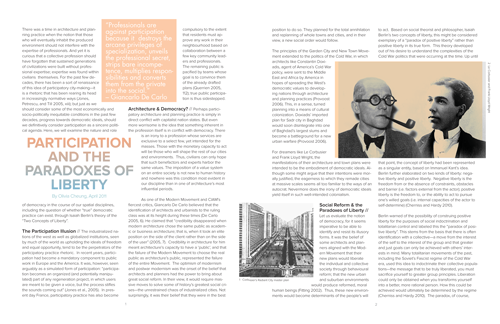(01 Participation & Liberty)

The Paradoxes of Liberty and Notes on Participation
The following excerpt from an essay explores notions of power and illusions of freedom and participation in architecture and urbanism, explored through Isaiah Berlin's "Two Concepts of Liberty". View the full text here.
"Professionals are against participation because it destroys the arcane privileges of specialization, unveils the professional secret, strips bare incompetence, multiplies responsibilities and converts them from the private into the social.”
– Giancarlo De Carlo’
There was a time in architecture and planning practice when the notion that those who will eventually inhabit the produced environment should not interfere with the expertise of professionals. And yet it is curious that a collective profession should have forgotten that sustained generations of civilizations were built without professional expertise; expertise was found within civilians themselves. For the past few decades, there has been a sort of renaissance of this idea of participatory city-making—it is a rhetoric that has been rearing its head in increasingly normative ways (Jones, Petrescu, and Till 2005, xiii); but just as we should consider some of the most economically and socio-politically inequitable conditions in the past few decades, progress towards democratic ideals, should we definitively consider participation as a sincere political agenda. Here, we will examine the nature and role of democracy in the course of our spatial disciplines, including the question of whether “true” democratic practice can exist. through Isaiah Berlin’s theory of the “Two Concepts of Liberty”.
The Participation Illusion
The industrialized nations of the west as well as globalized institutions, seen by much of the world as upholding the ideals of freedom and equal opportunity, tend to be the perpetrators of the participatory practice rhetoric. In recent years, participation had become a mandatory component to public work in Europe and the America. It was, however, seen arguably as a simulated form of participation: “participation becomes an organized (and potentially manipulated) part of any regeneration project, in which users are meant to be given a voice, but the process stifles the sounds coming out” (Jones et al., 2005). In present day France, participatory practice has also become compulsory to the extent that residents must approve any work in their neighbourhood based on collaboration between a few key community leaders and professionals. The remaining public is pacified by teams whose goal is to convince them of the already drafted plans (Querrien 2005, 112); true public participation is thus sidestepped.
Architecture & Democracy?
Perhaps participatory architecture and planning practice is simply in direct conflict with capitalist nation states. But even more worrisome is the idea that something inherent in the profession itself is in conflict with democracy. There is an irony to a profession whose services are exclusive to a select few, yet intended for the masses. Those with the monetary capacity to act will be those who will shape the rest of our cities and environments. Thus, civilians can only hope that such benefactors and experts harbor the same values. The imposition of a value system on an entire society is not new to human history and nowhere was this condition most evident in our discipline than in one of architecture’s most influential periods.
As one of the Modern Movement and CIAM’s fiercest critics, Giancarlo De Carlo believed that the identification of architects and urbanists to the ruling class was at its height during these times (De Carlo 2005, 6). He claimed that “credibility disappeared when modern architecture chose the same public as academic or business architecture; that is, when it took an elite position on the side of the client rather than on the side of the user” (2005, 7). Credibility in architecture for him meant architecture’s capacity to have a ‘public’, and that the failure of the Modern Movement to choose the real public as architecture’s public, represented the failure of the entire Movement. The optimism of modernism and postwar modernism was the onset of the belief that architects and planners had the power to bring about great social reform. In their view, it would require massive moves to solve some of history’s greatest social crises—the unrestrained chaos of industrialized cities. Not surprisingly, it was their belief that they were in the best position to do so. They planned for the total annihilation and replanning of whole towns and cities, and in their view, a new social order would follow.

Text, Images, Layout by Olivia Cheung
